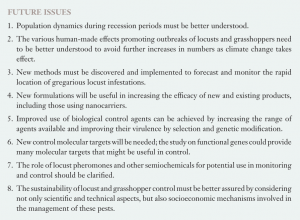As we discussed in earlier news posts, preventive locust management has the potential to severely reduce the impact of locust outbreaks if resources and coordination can appropriately align (Figure 1). Nonetheless, to be successfully implemented, preventive strategies are still in need of some research and further refinement. Many of the Global Locust Initiative’s partner organizations are continuously working towards improving preventive management, including some participants of GLI’s First International Conference in April of 2018.
Several of these individuals—Long Zhang, Michel Lecoq, Alexandre Latchininsky, and David Hunter—recently published an article in Annual Reviews of Entomology, Locust and Grasshopper Management, highlighting advances in preventive management and opportunities for future research and improvement. The last comprehensive review of this kind was published in 1960.
Among the many topics discussed in the review, the authors suggest that the variability among locust and grasshopper species can often impede a standard preventive management strategy. For example, of the roughly 6,700 grasshopper species, 500 can cause some damage to crops, 50 are considered severe pests, and only about 20 exhibit behaviors classically identified with locusts. Regardless of whether any given grasshopper species causes high or low levels of crop damage, the way any given species interacts with the environment is likely to vary.
As the authors point out, species differ in the way they move through the landscape, respond to rainfall and other environmental factors, touch other grasshoppers (which may lead to phase change), react to human-caused changes in the landscape, or even potentially feed on each other. Each of these behaviors may result in different preventive management strategies, including how each species may be monitored on the ground. For example, the authors mention that the South American locust (Schistocerca cancellata Seville), which is currently experiencing a 60-year outbreak, is prone to upsurges if rainfall occurs at key times during the locust’s life cycle.
Nonetheless, recent research developments in understanding locust behavior has contributed to increased understanding of various species, which can lead to better monitoring and forecasting.
Monitoring and forecasting (understanding where specific infestations are currently, where they are likely to move, and how fast they are likely to develop) are an important part of a preventive management strategy, as they can help in management of populations before they become severe enough to completely devastate a crop or cause significantly more in management costs. The adequate capture and management of data and information are an important part of monitoring and forecasting, and a variety of recently developed tools can aid in the process. Some of the many tools mentioned by the authors include satellite imagery, GIS-based systems employed by the Food and Agriculture Organization of the United Nations, and an advisory system developed for grasshoppers in rangelands in the United States.
A key piece of preventive management is the actual management of the pest insect, once it is understood where in time and space that pest insect is, and how likely it is to severely damage crops. The review authors also discuss a variety of recent advances in grasshopper and locust control. While many management programs are starting to move away from chemical pesticides, they remain an important tool in the control of large infestations. Nonetheless, other methods are common in management, including landscape modification (including various cultural control tactics), the reliance on pest natural enemies like parasitoids and predators (biological control), and the use of insect-killing fungi and nematodes (biopesticides).
The authors highlight that the sustainability (particularly of ongoing funding streams) and the risk management associated with preventive management are serious factors that need to be researched further to fully maintain the efficacy of any preventative management strategy. They end with a variety of “Future Issues” highlighting the need for ongoing coordination amongst locust researchers and local communities, and the need to continue research in various areas. These issues help underscore the need for the GLI network and the opportunities that exist for our members.
We look forward to continuing to examine these issues with the authors and others, and of course, we hope you will join us.

